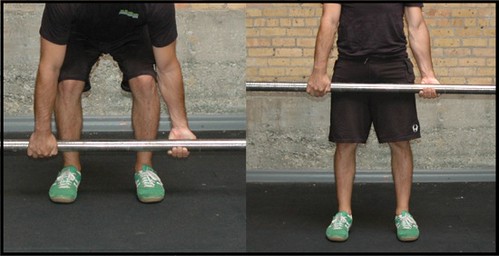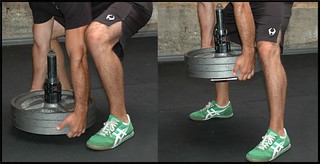I have a special treat for everyone today. Anyone who’s read this blog for any length of time knows I have a special place in my heart for three things:
Beef jerky (or any form of dead animal flesh, really), Star Wars, and deadlifts.
Today I have a guest post by Adam T. Glass. Adam is currently the No. 2 grip athlete in the country, setting records left and right, and head trainer at Movement Minneapolis.
He can do all sorts of freaky-deaky things like lift a crap load of weight, bend horseshoes, and rip the space-time continuum in half with his bare hands (the natural progression after phonebooks).
Adam reached out and asked if he could write a guest post on how improving grip strength can correlate very well to improved numbers with the deadlift. Of course I said yes.
Enjoy!
Almost inevitably, when I reveal to fellow lifters that I am a grip sport specialist, I get asked how to improve grip strength for these two lifts: deadlifts and pull-ups. Many people have been told that training these movements is enough for strong hands — and they believe it. In a sense, they’re right, but not training them the way most people do.
The issue is the equipment. Specifically, barbells and dumbbells are shaped to place minimal stress on the hands when training. A one-inch barbell is designed to be as small as it can be without digging into the palm or fingers. Any bigger and it’s harder to hold onto. A public demand for comfort has led to a narrowing of handles over the years, but that, in turn, has led to a weakening of the hands.
So, it won’t be very useful for me to simply tell you to abandon lifting straps and gloves, or to hold the bar for a beat longer at the top. Instead, I am going to share a few new ways that will actually improve your hand and wrist strength. Work these exercises into your routine and you will find that no longer does your grip fail you on a big pull, and as an added bonus, it will translate to more usable strength outside the gym.
THUMBLESS MIXED-GRIP FAT-BAR PULLING
Eliminating the thumb and placing more stress on the fingers and wrist will translate directly to more hand strength. Deadlifting with this grip — called the “monkey grip” — will train the arms as much as the hips and back. You will need a thick bar or a pair of the ever-popular slip-on grips. (There are a number on the market; the most popular are Fatgripz, the Manus Grips, and the Iron Bull grips. It won’t really matter which you choose for this movement.)
Place your thumb on the side of your index finger, turning your hand in to a flipper. Now set up on the bar with one palm facing you and one facing out in a mixed grip. You will find you have greater bicep and forearm loading here, too.

This is not something I would recommend you attempt at your 1RM deadlift on day one.
This is a grip-specific accessory movement, so use it on your back-off sets with more modest poundage. As you get stronger, you can work up very high weights as your wrist and fingers develop. You will be surprised at the feeling you find in your arm from shoulder to wrist the next day.
THE FLAT PLATE LIFT
How often have you had to lift something off the floor that wasn’t analogous to the familiar height of 45’s on a bar? Most objects we have to pull off the floor have a lower center of mass and more awkward shape than an easy-to-grip barbell. Related to barbell deadlifting, this will be similar to pulling from a significant deficit.
You will need a loading pin and two very secure locking collars. Start with a small,  thin plate or two and then load a few heavier plates on the loading pin, and finally lock down the apparatus with the collars on the top. Straddle the load, slide your fingers underneath both sides of the bottom plate, and lift it up a few inches. Be careful when you set it down to do it evenly so as to not crush your fingers.
thin plate or two and then load a few heavier plates on the loading pin, and finally lock down the apparatus with the collars on the top. Straddle the load, slide your fingers underneath both sides of the bottom plate, and lift it up a few inches. Be careful when you set it down to do it evenly so as to not crush your fingers.
This is the ever-feared combination of round-back lifting with bent arms that will supposedly destroy your spine faster than a side collision…and it’s also the exact same lift you are doing every time you lift a box off the floor. Let’s face it, lifting a 500-pound barbell off the floor is way easier than a 120-pound 36” X 36” box. The leverages are very different, so the joint positions are very different as well.
The plate lift gives you a similar starting position as stone lifting. Most people do not have access to stones, which is a shame, so try this one out instead.
Stay with relatively light weight, but you can expect to move some big weights sooner than later. You can become very strong in this position with some practice. For perspective, several (normal sized!) men in my facility can lift a 400+lb stack of plates.
THE LIFTING STRAP HOIST
It’s en vogue these days to bash lifting straps and people who use them, but that’s nonsense. Straps have their place. Even if you don’t use them, I will share with you an excellent lift that gives you a reason to keep a pair tucked in your gym bag.
Note from TG: I concur on the straps comment. They do have a time and place. I discuss that HERE (scroll to tip #5).
Load some weight on a bar and choke the straps onto the spots where you typically grab it. Position yourself as in a deadlift and grab the straps. This will put you in a neutral grip, with a very tight fist. From here simply hold on and stand up. How simple it that?

This type of lift will train your hand in the fully closed position, which is deceptively challenging. Most people have not trained any of their pulling motions with that tight of a grip.
So How Will This Help With My Deadlift?
A fair question. Slip these movements in to your training for a few weeks and you will find your fingers, wrist, and hand will get stronger fast.
One side effect of adding these in is a far greater volume of pulling weight off the floor, and that is likely a good thing for you. If you are not accustomed to using several types of pulls, it maybe best for you work in just one extra movement per week. For those who are used to doing work, throw them all in and use your better judgment for load and volume.
I will leave you with one specific tip with regard to your normal deadlifting practice. You may have already heard this, but if not it will be more valuable than anything more complicated: Start out your deadlift days with a double overhand grip.
Continue using that until you have to go to a mixed grip. Over the months and years — in addition to a few simple grip drills — you will develop an industrial strength grip.
Author Bio
Adam T. Glass is a world-class grip athlete and heads training at The Movement Minneapolis. He keeps a blog and training log at http://www.adamtglass.com/ and recently released a comprehensive grip training DVD titled Industrial Strength Grip.


